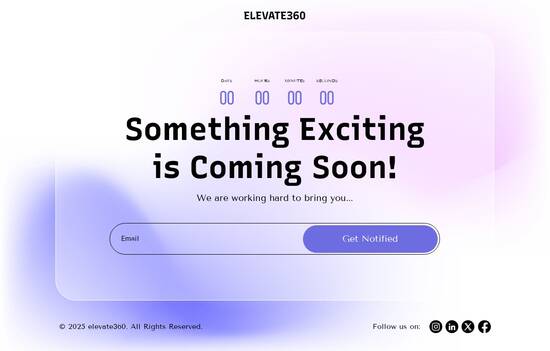
Eye-catching archive page template
Explore Similar TemplatesAbout template
Unleash your creativity with the eye-catching archive page template. Try Instapage today.
Recommended templates

Easy to build without coding
With the intuitive drag-and-drop builder, anyone on your team can create high-converting pages without any knowledge of code or design. Make enhancements to your landing page with custom widgets using Javascript, HTML/CSS, or third-party scripts.

Multiple layouts for any industry and goal
Select from 500+ landing page layouts built to boost conversions across industry-specific scenarios. Customize them by adjusting fonts, adding images, and generating on-brand content with the AI assistant. Quickly scale with Instablocks® and Global Blocks that you can save, reuse, and update globally.

Loads fast and looks polished on any device
Every template is responsive, which means they present professionally on any device and load blazingly fast with our Thor Render Engine. You can also power them up with Google AMP technology to deliver an unparalleled mobile experience and drive higher conversions.

Robust analytics & experimentation
Get real-time updates and reporting across all your devices, showing the number of visitors, conversions, cost-per-visitor, and cost-per-lead. Launch AI-powered experiments, run A/B tests, and use heatmaps to analyze user behavior, then optimize your landing page to maximize conversions.







Easy to build without coding
With the intuitive drag-and-drop builder, anyone on your team can create high-converting pages without any knowledge of code or design. Make enhancements to your landing page with custom widgets using Javascript, HTML/CSS, or third-party scripts.
Multiple layouts for any industry and goal
Select from 500+ landing page layouts built to boost conversions across industry-specific scenarios. Customize them by adjusting fonts, adding images, and generating on-brand content with the AI assistant. Quickly scale with Instablocks® and Global Blocks that you can save, reuse, and update globally.
Loads fast and looks polished on any device
Every template is responsive, which means they present professionally on any device and load blazingly fast with our Thor Render Engine.
Robust analytics & experimentation
Get real-time updates and reporting across all your devices, showing the number of visitors, conversions, cost-per-visitor, and cost-per-lead. Launch AI-powered experiments, run A/B tests, and use heatmaps to analyze user behavior, then optimize your landing page to maximize conversions.
All the features you need to build lead-generating landing pages
Explore more featuresLearn how to build top-performing landing pages for any goal
FAQs
Leading the way in building high-performing landing pages





Optimize your campaigns with Instapage’s powerful landing page platform
Landing page optimization is critical for maximizing the effectiveness of your digital marketing campaigns. With Instapage’s all-in-one platform, you can create high-converting landing pages that accelerate your campaigns, optimize user experience, and maximize return on investment (ROI). This guide will show you how to effectively leverage Instapage for your marketing needs.
Understanding the power of landing pages
Landing pages are specialized web pages designed to convert visitors into leads or customers. Using Instapage, marketers can develop unique pages tailored to specific campaigns without any coding skills. This flexibility allows teams to rapidly deploy marketing tactics that enhance user engagement.
- High-converting templates: Instapage offers 100+ ready-to-use templates designed for high conversion rates, making it easy to launch your campaigns.
- Data-driven optimization: Utilize detailed heatmaps and analytics to adjust on-page elements, increasing conversion potential.
- Collaborative features: Engage with your team through real-time editing and feedback, streamlining the production process.
Creating effective landing pages with templates
To get started with your first landing page, follow these simple steps:
- Select a template: Choose from a wide variety of high-converting templates that align with your campaign goals.
- Customize your page: Use the intuitive drag-and-drop builder to tailor elements like text, images, and lead capture forms.
- Publish and monitor: Once your page is ready, publish it and track performance metrics through Instapage’s analytics tools.
Leveraging A/B testing for optimization
Optimization is crucial in refining your landing pages. By conducting A/B tests, you can determine which page elements resonate best with your audience.
- Experiment with different headlines: Small changes in text can lead to significant differences in user engagement.
- Vary your call-to-action buttons: Test color, text, and placement to see what drives more conversions.
- Analyze user behavior: Use heatmaps to assess where users click most often, informing future design decisions.
By applying these strategies, you can not only enhance the effectiveness of your landing pages but also ensure that every marketing dollar spent contributes to your bottom line.
Start today with Instapage and see how easy it can be to create landing pages that convert.
Ready to transform your marketing efforts? Sign up for Instapage now and take the first step in optimizing your campaigns.
People also ask about Eye-catching archive page template
Understanding the Eye-Catching Archive Page Template: An Innovative Gateway to Sales Optimization
The concept of an archive page template
An archive page serves a critical role in e-commerce sites, acting as a hub where users can find grouped products or content in an organized format. Unlike other pages that may focus on individual products, the archive page aggregates information and creates a comprehensive view of offerings, effectively improving the customer journey. When done correctly, an eye-catching archive page template encourages more profound interactions, keeping visitors engaged longer, and guiding them toward purchases.
The importance of a well-designed archive page cannot be overstated—it enhances user experience by providing a clear, navigable layout that showcases products, promotions, and categories efficiently. This template fosters an environment where users can easily locate what they want, facilitating a seamless shopping experience. Additionally, a well-structured archive page makes it easier for customers to return, ensuring that they can quickly and effectively find past interests.
Aesthetic appeal: designing for impact
To create an eye-catching archive page template, focus on visual elements that grab attention. Color schemes should align with branding while also maintaining visual impact. A well-chosen palette can evoke emotions, and combined with the right typography, it establishes trust and partnership between the brand and its customers. Utilizing high-quality images and graphics is also paramount; they capture users' attention and reinforce the brand identity, transforming a basic page into a visually striking display.
Strategically using whitespace plays an essential role in making an archive page easy to read and interact with. Adequate spacing reduces cognitive overload and guides users' eyes to focal points, enhancing overall usability. In addition, a responsive design is crucial for e-commerce success, ensuring that the archive page looks great and functions well across all devices. Mobile responsiveness becomes indispensable with ever-increasing mobile shopping; integrating techniques, such as flexible grids and scalable images, allows for maintaining visual integrity and ensuring a positive user experience.
Navigation made simple: enhancing user journey
Intuitive navigation on archive pages is key to helping users find what they're looking for without hassle. Effective organization of products into distinct categories and subcategories provides a framework that users can follow easily. Furthermore, introducing filtering options—like categories, price ranges, and discount types—simplifies the browsing experience, allowing users to narrow down choices quickly and efficiently.
Incorporating a prominent search functionality also enhances navigation, offering quick access to specific products users may have in mind. The placement of search bars is vital; they should be easily visible, often at a consistent location across pages. Advanced sorting capabilities—like sorting by popularity, price, or new arrivals—further increase usability and satisfaction, transforming a simple archive page into a user-friendly experience that delights customers.
Showcasing products: the heart of engagement
Products are at the core of any archive page, and showcasing them effectively drives user engagement. A featured products or best-sellers section can spotlight items that are likely to drive sales, capturing visitor interest quickly. Regularly updating this section with dynamic content tailored to users’ preferences can convert casual browsers into buyers. This personalization is invaluable as it creates a sense of relevancy, encouraging deeper exploration across the archive page.
It's equally important to present product variations clearly—integrating options like size, color, and specifications without cluttering the design. Utilizing dropdowns or expandable sections ensures that customers can see all available choices efficiently, allowing them to feel empowered and informed when making decisions. Achieving this balance promotes an enjoyable browsing experience while directly impacting the potential for conversions.
Conversions through urgency and scarcity
Incorporating elements of urgency can significantly influence purchase decisions on archive pages. Features like countdown timers for limited-time offers prompt users to act quickly, fostering a fear of missing out on favorable deals. Low-stock notifications also create a sense of urgency, compelling indecisive shoppers to make purchases before items disappear. These tactics successfully harness psychological triggers that drive quick conversions, turning potential hesitations into immediate transactions.
Additionally, creatively displaying discount badges can effectively draw attention to special offers. Avoid ambiguity—strategic placements near product images or near the price can enhance visibility. Using vibrant colors or eye-catching fonts for these badges further influences buyer decisions. All of these tactics combine to tap into customer motivations, creating a powerful influence on purchasing behavior.
Crafting seamless integration with payment solutions
Streamlining the checkout process is critical for any archive page, empowering users to complete their purchases with minimal friction. A streamlined pathway from landing on an archive page to reaching the checkout should ideally include a few clicks at most. Consider options for direct checkout buttons as this not only facilitates convenience for users but also reduces the likelihood of cart abandonment, a common hurdle in e-commerce.
Integration of multiple payment solutions allows customers to choose their preferred payment method, enhancing satisfaction and security. Providing features such as currency selection is essential, particularly for global e-commerce. A single-page checkout reduces the hassle of multiple steps, while multi-step checkouts, despite their complexity, can organize information effectively. Analyzing customer preferences can guide the choice between these two methods, leading to tailored experiences that boost conversions.
Customer engagement beyond the purchase
Engagement should not end at the point of sale; building wishlists for future purchases contributes to customer retention. Incorporating wishlist functionality on archive pages allows customers to save items they’re interested in and return more easily. Accessibility plays a vital role; integrating an intuitive interface means customers have a constant option for keeping their options open, leading to more sales down the road.
Presenting customer reviews prominently on archive pages is another effective engagement strategy. Customer reviews enhance credibility, building trust with visitors who may be unfamiliar with a brand. Here, star ratings and user-generated content can significantly influence buying decisions, as potential customers often rely on the opinions of others to inform their choices. Showcasing these reviews thoughtfully encourages an engaging interaction and cultivates a loyal customer base.
Order management and stock product insights
Real-time inventory updates are essential for managing stock effectively from archive pages. Synchronizing the archive page with backend stock management systems ensures customers have accurate information about product availability. Vivid indications of low or out-of-stock items guide customers away from disappointment, while conveying transparency fosters trust in the shopping experience. Maintaining a robust inventory management system keeps products relevant and encourages timely replenishment.
Equally important is easy access to order histories for returning customers. Features like order tracking not only empower customers to monitor their shipping status but also reflect a brand’s commitment to customer satisfaction. Simplifying the review process for previous purchases builds loyalty; repeat customers are valuable assets, often contributing to overall revenue growth. Centralizing order management capabilities on archive pages reinforces customer relationships post-purchase.
Marketing and sales updates: keeping customers informed
A pro-active approach to marketing must be embedded within the archive page to communicate sales updates and promotions effectively. Employ strategies that prioritize key promotions without overwhelming visitors. Using strategically placed banners can capture attention while allowing more nuanced communication of limited-time offers. Pop-ups can also play a role; however, careful timing and design are essential to avoid deterring customers.
Incorporating newsletter and subscription options directly on the archive page is pivotal. Encouraging visitors to sign up provides a means of ongoing engagement and communication, keeping them in the loop about exclusive discounts and updates. To incentivize sign-ups, businesses can offer special deals for subscribers, creating a win-win scenario that enhances overall customer relationships.
Customization and personalization
Offering customization options directly from archive pages makes a significant impact on user satisfaction. Simple and intuitive UI elements enable users to modify their choices seamlessly, whether it’s choosing colors or sizes. This responsive feature allows for a more tailored experience and addresses user preferences directly, enhancing their perception of the brand.
Product bundling techniques can encourage higher average order values. By showcasing complimentary products or enticing bundles, users are more likely to explore offers that seem valuable. Furthermore, tracking user behavior provides essential insights for personalization, allowing businesses to adapt content and product suggestions to fit specific interests. Adaptive content ensures continuous relevance, keeping users engaged and encouraging conversions.
All-in-one addons for enhanced functionality
Enhancing the archive page experience can be achieved by integrating various addons that enrich interaction with visitors. Live chat options provide real-time support, offering assistance that can lead to immediate sales conversions. Including links to social media channels encourages brand interaction across platforms, driving traffic back to the website and fostering community engagement.
Utilizing analytics tools to measure performance is crucial for understanding user behavior. It’s important to monitor key performance indicators (KPIs), such as bounce rates and time spent on the page, to gauge effectiveness. Analyzing these insights provides an opportunity for continual iteration and improvement, ensuring that the archive page evolves in line with user feedback and trends.
Best practices for implementing an eye-catching archive page template
Learning from real-world examples of successful archive pages can guide effective implementation. Identify characteristics that make them stand out—such as their visual layout, product accessibility, and responsive design. Once you understand these elements, begin creating your own visually stunning and functional archive page. Start with an actionable checklist that includes essential elements like navigation effectiveness, visual appeal, and integrated functionalities.
Continuously seek customer feedback about the archive page functionalities. Analyze sales performance post-implementation and be prepared to adapt the layout or offerings based on evolving preferences. Engaging in continual improvement based on data will keep the archive page relevant and effective, ensuring the best possible experience for users.
Future trends in archive page design
As technology advances, emerging trends will likely reshape how archive pages function in the e-commerce sector. AI-driven customization and enhanced user interfaces focused on voice search and augmented reality can completely revamp user experiences. Keeping an eye on these innovations ensures businesses can leverage them to improve customer engagement and conversions in the future.
Predictions indicate that user interfacing will evolve, with a continuing push toward more personalized and immersive shopping experiences. Businesses need to prepare for these shifts, focusing on integration capabilities and flexible layouts that adapt to fluid customer interactions. Adapting to these changes will be central to thriving in the competitive digital landscape, leading to sustained growth and better customer relationships.
Ready to skyrocket conversions?
Supercharge your ad campaigns with high-performing landing pages
Get started














